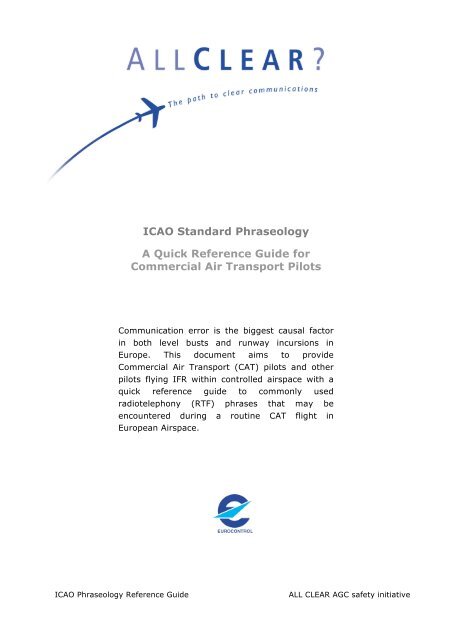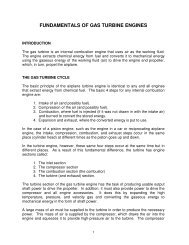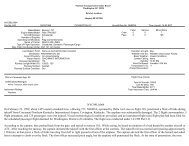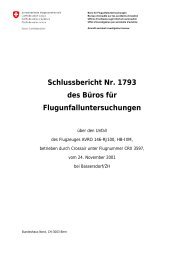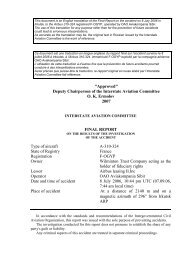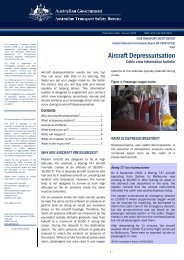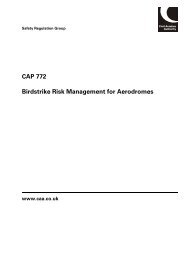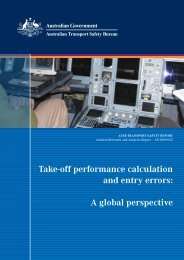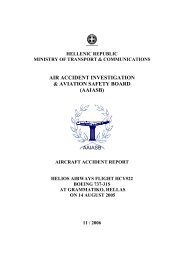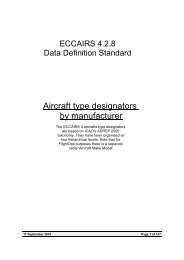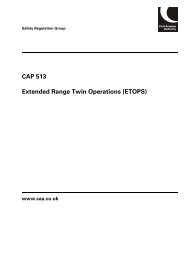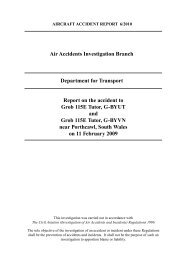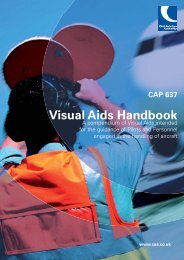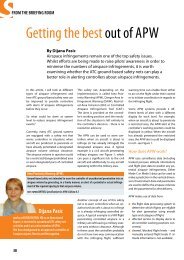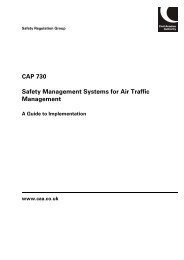ICAO Standard Phraseology A Quick Reference Guide for - SKYbrary
ICAO Standard Phraseology A Quick Reference Guide for - SKYbrary
ICAO Standard Phraseology A Quick Reference Guide for - SKYbrary
Create successful ePaper yourself
Turn your PDF publications into a flip-book with our unique Google optimized e-Paper software.
<strong>ICAO</strong> <strong>Standard</strong> <strong>Phraseology</strong><br />
A <strong>Quick</strong> <strong>Reference</strong> <strong>Guide</strong> <strong>for</strong><br />
Commercial Air Transport Pilots<br />
Communication error is the biggest causal factor<br />
in both level busts and runway incursions in<br />
Europe. This document aims to provide<br />
Commercial Air Transport (CAT) pilots and other<br />
pilots flying IFR within controlled airspace with a<br />
quick reference guide to commonly used<br />
radiotelephony (RTF) phrases that may be<br />
encountered during a routine CAT flight in<br />
European Airspace.<br />
<strong>ICAO</strong> <strong>Phraseology</strong> <strong>Reference</strong> <strong>Guide</strong> ALL CLEAR AGC safety initiative
Introduction<br />
Communication error is the biggest causal factor in both level busts and runway<br />
incursions in Europe. This document aims to provide Commercial Air Transport<br />
(CAT) pilots and other pilots flying IFR within controlled airspace with a quick<br />
reference guide to commonly used radiotelephony (RTF) phrases that may be<br />
encountered during a routine CAT flight in European Airspace. It also explains<br />
some of the rationale behind the use of certain words and phrases to aid<br />
understanding and rein<strong>for</strong>ce the need <strong>for</strong> compliance with standard phraseology.<br />
The goal is to improve safety by raising RTF standards.<br />
The need <strong>for</strong> clear and unambiguous communication between pilots and Air<br />
Traffic Control (ATC) is vital in assisting the safe and expeditious operation of<br />
aircraft. It is important, there<strong>for</strong>e, that due regard is given to the use of<br />
standard words and phrases and that all involved ensure that they maintain the<br />
highest professional standards when using RTF. This is especially important<br />
when operating within busy sectors with congested frequencies where any time<br />
wasted with verbosity and non-standard, ambiguous phrases could lead to flight<br />
safety incidents.<br />
<strong>Phraseology</strong> has evolved over time and has been carefully developed to provide<br />
maximum clarity and brevity in communications while ensuring that phrases are<br />
unambiguous. However, while standard phraseology is available to cover most<br />
routine situations, not every conceivable scenario will be catered <strong>for</strong> and RTF<br />
users should be prepared to use plain language when necessary following the<br />
principle of keeping phrases clear and concise.<br />
<strong>ICAO</strong> <strong>Phraseology</strong> <strong>Reference</strong> <strong>Guide</strong> 2 ALL CLEAR AGC safety initiative
Contents<br />
1. Clearance and Taxi<br />
2. Take-off and Departure<br />
3. Read-back<br />
4. Climb, Cruise and Descent<br />
5. Approach and Landing<br />
6. Emergency Communications<br />
Note:<br />
This document uses RTF examples showing both pilot (denoted by blue italic<br />
text) and ATCO (denoted by grey text) communication. For example:<br />
Pilot - Metro Ground, Big Jet 345, request taxi<br />
ATC - Big Jet 345, Metro Ground, taxi to holding point A1, hold short of Runway<br />
18<br />
<strong>ICAO</strong> <strong>Phraseology</strong> <strong>Reference</strong> <strong>Guide</strong> 3 ALL CLEAR AGC safety initiative
CLEARANCE AND TAXI<br />
<strong>ICAO</strong> <strong>Phraseology</strong> <strong>Reference</strong> <strong>Guide</strong> 4 ALL CLEAR AGC safety initiative
Taxiing - A Safety Critical Activity<br />
RTF is crucial to the safety of the flight during taxiing. Any mistake that causes<br />
the aircraft to enter a runway in error could be catastrophic.<br />
Taxi Clearance Limit<br />
All taxi clearances will contain a clearance limit, which is the point at which the<br />
aircraft must stop unless further permission to proceed is given.<br />
Noting Down Taxi Clearances<br />
Complex or lengthy taxi clearances should be noted down by crews.<br />
RTF Taxi Instructions to Departure Runway<br />
Metro Ground, Big Jet 345, request taxi<br />
Big Jet 345, Metro Ground, taxi to holding point C, runway 27<br />
Taxi to holding point C, runway 27, Big Jet 345<br />
Big Jet 345, contact Metro Tower 119.2<br />
Contact Metro Tower 119.2, Big Jet 345<br />
Crossing an Intermediate Runway<br />
If a taxi route involves crossing a runway, whether active or not, specific<br />
clearance to cross that runway is required.<br />
Departure Delay In<strong>for</strong>mation<br />
Departure sequence in<strong>for</strong>mation such as ‘number 5 to depart’ or ‘expect<br />
departure in …’ is NOT a take-off clearance.<br />
RTF Taxiing Across an Intermediate Runway<br />
Metro Ground, Big Jet 345, request taxi<br />
Big Jet 345, Metro Ground, taxi to holding point A1 runway 18<br />
Taxi to holding point A1 runway 18, Big Jet 345<br />
When traffic permits<br />
Big Jet 345 cross runway 18 at A1, taxi to holding point C, runway 27<br />
Cross runway 18 at A1, taxi to holding point C, runway 27, Big Jet 345<br />
<strong>ICAO</strong> <strong>Phraseology</strong> <strong>Reference</strong> <strong>Guide</strong> 5 ALL CLEAR AGC safety initiative
NB: ATC may request Big Jet to confirm when Runway 18 is vacated<br />
A Conditional Taxi Clearance<br />
Conditional clearances may expedite traffic flow, but there are risks. Read-back<br />
must be in full and in the same sequence as given. A taxi clearance, shown<br />
below, allows taxi after another action has first taken place ie. the condition of<br />
the clearance. Where there may be ambiguity as to the subject of the condition,<br />
additional details such as livery and/or colour are given to aid identification.<br />
A conditional taxi clearance allows the aircraft to taxi only after another action<br />
has taken place. The structure and order of conditional clearances is essential to<br />
their safe execution.<br />
Correct read-back of a conditional clearance is vital.<br />
Metro Delivery, Big Jet 345, Stand Bravo 1, Boeing 737 with in<strong>for</strong>mation Q,<br />
QNH1006, request clearance<br />
Big Jet 345, Metro Delivery, Cleared to Smallville, T1A departure,<br />
Squawk 3456, slot time 1905<br />
Cleared to Smallville, T1A, Squawk 3456, Big Jet 345<br />
Big Jet 345, request start up<br />
Big Jet 345, start up approved, contact Metro Ground 118.750 <strong>for</strong> taxi<br />
instructions<br />
Start up approved, contact Metro Ground 118.750 <strong>for</strong> taxi instructions, Big Jet<br />
345<br />
Metro Ground, Big Jet 345 Stand B1, request taxi<br />
Big Jet 345, Metro Ground, after the red and white Antonov with the<br />
purple fin, taxi to holding point runway 08<br />
After the red and white Antonov with the purple fin, taxi to holding point runway<br />
08, Big Jet 345<br />
<strong>ICAO</strong> <strong>Phraseology</strong> <strong>Reference</strong> <strong>Guide</strong> 6 ALL CLEAR AGC safety initiative
*<strong>ICAO</strong>:<br />
In all cases a conditional clearance shall be given in the following order and<br />
consist of:<br />
1. Identification;<br />
2. The condition<br />
3. The clearance; and<br />
4. Brief reiteration of the condition<br />
Conditional clearance to cross the intermediate runway:<br />
Conditional phrases, such as “behind landing aircraft” or “after departing<br />
aircraft”, shall not be used <strong>for</strong> movements affecting the active runway(s), except<br />
when the aircraft or vehicles concerned are seen by the appropriate controller<br />
and pilot. The aircraft or vehicle causing the condition in the clearance issued<br />
shall be the first aircraft/vehicle to pass in front of the other aircraft concerned.<br />
NB: Beware - the <strong>ICAO</strong> phrase ‘behind’ has been misinterpreted as an<br />
instruction to ‘get close to’ the preceding aircraft, leading to serious jet blast<br />
incidents.<br />
Big Jet 345, after landing Airbus 321, cross Runway 09 at C2, after<br />
After landing Airbus 321, cross Runway 09 at C2 after, Big Jet 345<br />
Then:<br />
Big Jet 345, taxi to holding point C1, runway 27<br />
Taxi to holding point C1, runway 27, Big Jet 345<br />
Then:<br />
Big Jet 345, contact Metro Tower 123.625<br />
Contact Metro Tower 123.625, Big Jet 345<br />
<strong>ICAO</strong> <strong>Phraseology</strong> <strong>Reference</strong> <strong>Guide</strong> 7 ALL CLEAR AGC safety initiative
TAKE OFF AND DEPARTURE<br />
‘Take-off’ shall only be used when issuing a clearance to take-off.<br />
§� Do not use phrases such as ‘prior to take-off’ or ‘after take-off’.<br />
§� If the controller uses ‘after departure’ or ‘follow’, this is NOT a clearance to<br />
take-off.<br />
Any instructions to HOLD, HOLD POSITION or HOLD SHORT OF, shall be read<br />
back in full using the appropriate phrase – HOLDING or HOLD SHORT OF.<br />
In the airport environment, the word ‘cleared’ shall only be used in connection<br />
with a clearance to take-off or land. To aid clarity, a take-off clearance will<br />
always be issued separately.<br />
RTF Take-off Clearance<br />
Metro Tower, Big Jet 345, approaching holding point C1<br />
Big Jet 345, Metro Tower, line up runway 27<br />
Lining up runway 27, Big Jet 345<br />
Big Jet 345, runway 27, cleared <strong>for</strong> take-off<br />
Cleared <strong>for</strong> take-off, Big Jet 345<br />
Once airborne:<br />
Big Jet 345, contact Metro Radar 124.6<br />
Contact Metro Radar on 124.6, Big Jet 345<br />
Amendment to Departure Clearance<br />
Amendments to departure clearances are known to contribute to runway<br />
incursion incidents.<br />
The phraseology <strong>for</strong> amendments to departure clearances where the aircraft is<br />
approaching the runway will begin with ‘hold position’.<br />
<strong>ICAO</strong> <strong>Phraseology</strong> <strong>Reference</strong> <strong>Guide</strong> 8 ALL CLEAR AGC safety initiative
RTF Amendment to Departure Clearance<br />
Metro Tower, Big Jet 345, approaching holding point C1<br />
Big Jet 345, Metro Tower, hold at C1<br />
Hold at C1, Big Jet 345<br />
Big Jet 345, hold position, amendment to clearance, T3F departure, climb to<br />
6000 feet<br />
Holding, T3F departure, climb to 6000 feet, Big Jet 345<br />
Or:<br />
Big Jet 345 hold position, after departure climb to altitude 6000 feet<br />
Holding, after departure climb to 6000 feet, Big Jet 345<br />
Conditional Line-Up Clearance<br />
Important points involving the active runway:<br />
§� The condition is always given directly after the call-sign and be<strong>for</strong>e the<br />
clearance.<br />
§� Conditional clearances must be read back in full and in exactly the same<br />
sequence as given plus a brief reiteration of the condition.<br />
§� The aircraft or vehicle that is the subject of the condition must be visible to<br />
the flight crew and the controller.<br />
§� The subject aircraft or vehicle of the condition shall be the next<br />
aircraft/vehicle to pass.<br />
§� The condition must relate to only one movement.<br />
§� Always clarify if unsure.<br />
RTF A Conditional Line Up Clearance<br />
Metro Tower, Big Jet 345, approaching holding point C1<br />
Big Jet 345, Metro Tower, hold at C1<br />
Hold at C1, Big Jet 345<br />
Conditional line up clearance:<br />
Big Jet 345, behind landing Boeing 757, line up runway 27, behind<br />
Behind landing Boeing 757, line up runway 27, behind, Big Jet 345<br />
<strong>ICAO</strong> <strong>Phraseology</strong> <strong>Reference</strong> <strong>Guide</strong> 9 ALL CLEAR AGC safety initiative
Cancelling Take-off Clearance<br />
If take-off clearance has to be cancelled be<strong>for</strong>e the take-off roll has commenced,<br />
the flight crew shall be instructed to hold position, stating reason.<br />
If it is necessary to cancel take-off clearance after the aircraft has commenced<br />
the take-off roll, the flight crew shall be instructed to stop immediately.<br />
RTF Cancelling Take-off Clearance<br />
Aircraft has not commenced take-off roll:<br />
Big Jet 345 hold position, Cancel take-off, I say again cancel take-off due to<br />
vehicle on the runway<br />
Holding, Big Jet 345<br />
Aircraft has commenced take-off roll:<br />
Big Jet 345 stop immediately, (Big Jet 345 stop immediately)!<br />
Stopping, Big Jet 345<br />
<strong>ICAO</strong> <strong>Phraseology</strong> <strong>Reference</strong> <strong>Guide</strong> 10 ALL CLEAR AGC safety initiative
READ-BACK<br />
Read-back is vital <strong>for</strong> ensuring mutual understanding between the pilot and the<br />
controller of the intended plan <strong>for</strong> that aircraft.<br />
§� Following correct read-back the flight crew must ensure that they carry out<br />
the correct action. Statistics show that one of the most common causes of a<br />
level bust in Europe is correct read-back followed by incorrect action.<br />
§� Strategies to prevent the above error include noting down the clearance<br />
prior to read-back and ensuring that both flight crew members listen to all<br />
clearances, including taxi clearance. If in doubt check!<br />
Any safety related message or part of message transmitted by voice must<br />
always be read-back.<br />
The Following Shall Always Be Read Back<br />
§� Taxi instructions<br />
§� Level instructions<br />
§� Heading instructions<br />
§� Speed instructions<br />
§� Airways/route clearances<br />
§� Approach clearances<br />
§� Runway in use<br />
§� All clearances affecting any runway<br />
§� SSR operating instructions<br />
§� Altimeter settings<br />
§� VDF in<strong>for</strong>mation<br />
§� Type of radar service<br />
§� Transition levels<br />
Frequency changes should always be read-back in full.<br />
Checking the accuracy of a read-back is far easier if the in<strong>for</strong>mation is read back<br />
in the same order as given. Omissions are more difficult to pick up than incorrect<br />
data.<br />
§� When a read-back is required ensure it is complete and in the order<br />
given.<br />
§� Always listen <strong>for</strong> (and check) ATC confirmation or correction of read-<br />
back.<br />
<strong>ICAO</strong> <strong>Phraseology</strong> <strong>Reference</strong> <strong>Guide</strong> 11 ALL CLEAR AGC safety initiative
CLIMB, CRUISE AND DESCENT<br />
Initial Calls<br />
Studies show that an initial call which does not contain all the required<br />
in<strong>for</strong>mation can lead to a loss of separation. On first contact after departure<br />
include:<br />
§� Call-sign<br />
§� SID<br />
§� Current or passing level plus cleared level<br />
The in<strong>for</strong>mation in the initial call is essential <strong>for</strong> the safety of the aircraft by<br />
ensuring mutual understanding between the crew and the controller of the<br />
intention <strong>for</strong> the aircraft.<br />
Omissions will require an additional call <strong>for</strong> clarification which may lead to<br />
frequency congestion.<br />
On first contact with subsequent frequencies include call-sign (and wake<br />
turbulence category if ‘heavy’) and:<br />
§� Level , including passing and cleared level if not maintaining the cleared<br />
level<br />
§� Cleared level (if different from current level)<br />
§� Speed (if assigned by ATC), and<br />
§� Other ATC clearances assigned.<br />
RTF Initial Call<br />
Big Jet 345, runway 27, cleared <strong>for</strong> take-off<br />
Cleared <strong>for</strong> take-off, runway 27 Big Jet 345<br />
Once airborne:<br />
Big Jet 345, contact Metro Radar 124.6<br />
Contact Metro Radar 124.6, Big Jet 345<br />
Initial call to radar:<br />
Metro Radar, Big Jet 345, T3F, passing 2300 feet climbing to 6000 feet,<br />
Big Jet 345, Metro Radar, radar contact<br />
<strong>ICAO</strong> <strong>Phraseology</strong> <strong>Reference</strong> <strong>Guide</strong> 12 ALL CLEAR AGC safety initiative
Degrees<br />
Headings ending in zero can easily be confused with flight levels (this confusion<br />
can be avoided by appending the word ‘degrees’, however this is not an <strong>ICAO</strong><br />
requirement or recommendation).<br />
Flight Levels<br />
Flight levels below FL100 are referred to as two digit numbers e.g. Climb flight<br />
level eight zero to reduce the risk of confusion with a heading instruction eg.<br />
heading zero eight zero.<br />
Flight levels 100, 200 and 300 are often confused <strong>for</strong> 110, 210 and 310: special<br />
care should be taken when enunciating ‘zero zero’.<br />
En-Route RTF<br />
RTF En-Route Examples<br />
Big Jet 345, fly heading 260 (degrees), climb to FL 100, no speed restrictions<br />
Fly heading 260 (degrees), climb to FL 100, no speed restrictions, Big Jet 345<br />
Big Jet 345, fly direct BONNY, climb to FL 360<br />
Direct BONNY, climb to FL 360, Big Jet 345<br />
Big Jet 345, contact Northern Control, 132.6<br />
Contact Northern Control, 132.6, Big Jet 345<br />
Northern Control, Big Jet 345, passing FL240 climbing to FL 360, direct BONNY<br />
Big Jet 345, Northern Control, fly direct CLYDE<br />
Direct CLYDE, Big Jet 345<br />
<strong>ICAO</strong> <strong>Phraseology</strong> <strong>Reference</strong> <strong>Guide</strong> 13 ALL CLEAR AGC safety initiative
Reduced Vertical Separation Minima<br />
§� Flight crew shall report RVSM approved status with ‘Affirm RVSM’ and report<br />
RVSM non-approved with ‘Negative RVSM’ followed by reason.<br />
§� Flight crew denying ATC clearance into RVSM shall state ‘Unable RVSM’<br />
followed by the reason, <strong>for</strong> example ‘Unable RVSM due turbulence’ or<br />
‘Unable RVSM due equipment’.<br />
§� Flight crew able to resume RVSM shall use the phrase ‘Ready to resume<br />
RVSM’.<br />
§� ATC should be in<strong>for</strong>med when a non-RVSM approved State aircraft is<br />
requesting climb into RVSM airspace thus ‘…Request FL320, Negative RVSM’.<br />
If able, ATC will give the clearance as follows ‘…Climb to FL 320, Negative<br />
RVSM’. Notice that the term ‘Negative RVSM’ is used in the clearance and the<br />
read-back, thus ‘Climb to FL 320, Negative RVSM…’. Otherwise ATC will state<br />
that they are unable to issue the clearance into RVSM airspace.<br />
RTF <strong>for</strong> TCAS<br />
Once an aircraft departs from its ATC clearance or instruction in compliance with<br />
an RA, or a pilot reports an RA, the controller ceases to be responsible <strong>for</strong><br />
providing separation between that aircraft and any other aircraft affected as a<br />
direct consequence of the manoeuvre induced by the RA.<br />
If an RA is causing departure from the ATC clearance<br />
(Callsign) TCAS RA (pronounced "TEE-CAS-AR-AY").<br />
When returning to assigned clearance<br />
(Callsign) CLEAR OF CONFLICT, RETURNING TO (assigned clearance).<br />
When the assigned ATC clearance has been resumed<br />
(Callsign) CLEAR OF CONFLICT (assigned clearance) RESUMED<br />
When an ATC clearance contradictory to the ACAS RA is received,<br />
the flight crew will follow the RA and in<strong>for</strong>m ATC directly<br />
(Callsign) UNABLE, TCAS RA.<br />
<strong>ICAO</strong> <strong>Phraseology</strong> <strong>Reference</strong> <strong>Guide</strong> 14 ALL CLEAR AGC safety initiative
Conditional Clearances<br />
Conditional clearances can be issued eg. in the TMA. ‘After passing altitude 4000<br />
feet, fly heading…’ These must be treated with great care and read back in<br />
exactly the same <strong>for</strong>mat in which they are given. If in doubt – check! Writing<br />
down such clearances should help in preventing a conditional clearance being<br />
neglected.<br />
Avoiding Action<br />
Lateral Avoiding Action<br />
Big Jet 345, turn left (or right) immediately heading 270 (or 30 degrees)! to<br />
avoid traffic at 2 o’clock, 5 miles crossing right to left, 500 feet below<br />
Vertical Avoiding Action<br />
Big Jet 345, climb (or descend) immediately to FL 160, traffic at 12 o’clock 3<br />
miles opposite direction, same level<br />
An urgent tone shall be used<br />
RTF <strong>for</strong> VHF frequencies – Use of Six Digits<br />
Use six digits except where the final two digits of the frequency are both zero, in<br />
which case only the first four digits need to be transmitted.<br />
<strong>ICAO</strong> <strong>Phraseology</strong> <strong>Reference</strong> <strong>Guide</strong> 15 ALL CLEAR AGC safety initiative
Simultaneous or Continuous Transmissions<br />
Direct controller – pilot communication can be adversely affected by<br />
simultaneous or continuous transmissions. There are times when the controller<br />
is not aware of a blocked transmission, but a pilot is. On hearing a simultaneous<br />
transmission it can be helpful if a pilot in<strong>for</strong>ms ATC that the transmission was<br />
BLOCKED.<br />
Transmission blocked, Big Jet 345<br />
To and For<br />
Use of the word ‘to’ directly be<strong>for</strong>e a climb/descent instruction or change of<br />
heading can be confused as ‘two’. Such confusion is avoided by using the<br />
mandatory words ‘flight level’ or ‘heading’ immediately be<strong>for</strong>e the numbers.<br />
Big Jet 345, climb to FL180.<br />
Big Jet 345, turn left to heading 310 degrees.<br />
There are also occasions where inappropriate use of the word ‘<strong>for</strong>’ can introduce<br />
confusion if it is interpreted as the number ‘four’.<br />
Wake Vortex Separation Requests<br />
Do not ask <strong>for</strong> reduced vortex wake separation; controllers do not have<br />
discretion to grant this.<br />
<strong>ICAO</strong> <strong>Phraseology</strong> <strong>Reference</strong> <strong>Guide</strong> 16 ALL CLEAR AGC safety initiative
APPROACH AND LANDING<br />
Pilot-interpreted Approaches (eg ILS) <strong>Phraseology</strong><br />
The phrase ‘cleared ILS approach runway xx’ has, in the past, introduced<br />
some ambiguity whereby pilots have taken this to mean they are cleared to the<br />
altitude/height depicted on the approach chart immediately prior to the final<br />
approach fix. This should not be assumed; normally clearances to descend at<br />
this point will be given distinctly.<br />
Other phrases that are commonly in use include:<br />
‘Report established localiser (or ILS, GBAS/SBAS/MLS approach course).’<br />
‘Maintain (altitude) until intercepting glide-path.’<br />
‘Report established on glide-path.’<br />
RTF Radar Vectors from the HOLD towards the ILS<br />
Metro Approach, Big Jet 345, Boeing 737 with in<strong>for</strong>mation P, Holding MAYFIELD<br />
descending FL 80<br />
Big Jet 345, Metro Approach, now in<strong>for</strong>mation Q, new QNH 998<br />
QNH 998, Big Jet 345<br />
Big Jet 345, leave MAYFIELD, heading 120 descend to 6000 feet, QNH 998,<br />
speed 210 knots<br />
Heading 120, descend to 6000 feet, QNH 998, speed 210 knots, Big Jet 345<br />
Big Jet 345, turn right heading 180, speed 180 knots, vectoring ILS runway 27<br />
Right<br />
Right heading 180, speed 180 knots, Big Jet 345<br />
RTF –ILS continued:<br />
Big Jet 345, turn right heading 240, descend to 3000 feet, report established<br />
localiser runway 27 Right<br />
Right heading 240, descend to 3000 feet, report established localiser runway 27<br />
Right, Big Jet 345<br />
Big Jet 345, established localiser<br />
Big Jet 345, cleared ILS approach runway 27 Right,<br />
Cleared ILS approach runway 27 right, Big Jet 345<br />
Or in busy RTF situations:<br />
Big Jet 345, turn right heading 240 degrees, cleared ILS approach runway 27<br />
Right, maintain 3000ft, until glide-path interception<br />
<strong>ICAO</strong> <strong>Phraseology</strong> <strong>Reference</strong> <strong>Guide</strong> 17 ALL CLEAR AGC safety initiative
Turning right heading 240, cleared ILS approach runway 27 Right, maintain<br />
3000 ft until glide-path runway 27 right<br />
Continue Approach<br />
If the runway is obstructed when the aircraft reports ‘final’, but it is expected to<br />
be available in good time <strong>for</strong> the aircraft to make a safe landing, the controller<br />
will delay landing clearance by issuing an instruction to ‘continue approach’. The<br />
controller may explain why the landing clearance has been delayed. An<br />
instruction to ‘continue’ is NOT a clearance to land.<br />
RTF Continue Approach<br />
Metro Tower, Big Jet 345, final runway 27 Right<br />
Big Jet 345, continue approach<br />
Continue approach, Big Jet 345<br />
Big Jet 345, cleared to land, runway 27 Right, wind 270 degrees ten knots<br />
Cleared to land runway 27 Right, Big Jet 345<br />
The Go-Around<br />
Instructions to carry out a missed approach may be given to avert an unsafe<br />
situation. When a missed approach is initiated cockpit workload is inevitably<br />
high.<br />
§� Any transmissions to aircraft going around shall be brief and kept to a<br />
minimum.<br />
§� In the event of a missed approach being initiated by the pilot, the phrase<br />
‘going around’ should be used.<br />
RTF the Go-Around<br />
Controller Initiated:<br />
Big Jet 345, go around<br />
Going around, Big Jet 345<br />
Pilot initiated:<br />
Big Jet 345, going around<br />
Roger (followed by suitable instruction)<br />
<strong>ICAO</strong> <strong>Phraseology</strong> <strong>Reference</strong> <strong>Guide</strong> 18 ALL CLEAR AGC safety initiative
EMERGENCY COMMUNICATIONS<br />
RTF Emergency Communications<br />
As soon as there is any doubt as to the safe conduct of a flight, immediately<br />
request assistance from ATC. Flight crews should declare the situation early; it<br />
can always be cancelled.<br />
§� A distress call (situation where the aircraft requires immediate assistance) is<br />
prefixed: MAYDAY, MAYDAY, MAYDAY.<br />
§� An urgency message (situation not requiring immediate assistance) is<br />
prefixed:<br />
PAN-PAN, PAN-PAN, PAN-PAN.<br />
§� Make the initial call on the frequency in use, but if that is not possible<br />
squawk 7700 and call on 121.5.<br />
§� The distress/urgency message shall contain (at least) the name of the<br />
station addressed, the call-sign, nature of the emergency, fuel endurance<br />
and persons on board; and any supporting in<strong>for</strong>mation such as position,<br />
level, (descending), speed and heading, and pilot’s intentions.<br />
RTF Emergency Communications<br />
MAYDAY, MAYDAY, MAYDAY, Metro Control, Big Jet 345, main electric failure,<br />
request immediate landing at Metro, position 35 miles north west of Metro,<br />
heading 120 flight level 80 descending, 150 persons on board, endurance three<br />
hours<br />
Big Jet 345, Roger the MAYDAY, turn left heading 090, radar vectors ILS runway<br />
27<br />
Big Jet 345 request runway 09<br />
Big Jet 345, roger, turn right heading 140 <strong>for</strong> radar vectoring runway 09,<br />
descend to 3000 feet, QNH 995, report established<br />
Big Jet 345, heading 140, descend to 3000 feet QNH 995 , report established<br />
localiser runway 09<br />
Fuel Reserves Approaching Minimum<br />
’Fuel Emergency’ or ‘fuel priority’ are not recognised terms. Flight crews<br />
short of fuel must declare a PAN or MAYDAY to be sure of being given the<br />
appropriate priority.<br />
<strong>ICAO</strong> <strong>Phraseology</strong> <strong>Reference</strong> <strong>Guide</strong> 19 ALL CLEAR AGC safety initiative
Radio Failure<br />
Over recent years the number of reported radio failure incidents has increased<br />
considerably. With the heightened awareness in airborne security, ATC’s inability<br />
to contact an aircraft experiencing a radio failure could lead to that aircraft’s<br />
interception by military aircraft.<br />
Pilots should familiarise themselves with loss of communications procedures<br />
and/or sleeping receiver procedures, including the use of 121.5 MHz.<br />
Operators should ensure that ATC Units have readily available 24 hour contact<br />
details of company flight operations control.<br />
<strong>ICAO</strong> <strong>Phraseology</strong> <strong>Reference</strong> <strong>Guide</strong> 20 ALL CLEAR AGC safety initiative


